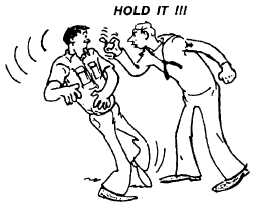| |
response on your part may serve to justify the
customer’s negative attitude.
A calm, confident manner is the best approach.
When you do not respond with anger or rudeness to a
customer’s emotional outburst, you have taken the first
step toward solving the customer’s problem, whatever
its nature.
Maintaining Self-Control
Earlier when we discussed your attitude toward
customers, we were taking about customers in general.
Although personal interaction isn’t difficult when your
customers are pleasant, it may become difficult when
the person is unpleasant.
Occasionally, you will have a customer who seems
to rub you the wrong way. No matter how hard you try,
you can’t remain pleasant or friendly because of the
customer’s attitude or manner of speaking. In this
situation the best solution is usually to keep the contact
as impersonal as possible. Ignore the customer’s manner
and attitude and concentrate on the problem.
Your performance is viewed by the customer, your
coworkers, and your supervisor. For them to rate you as
a person who does your best work, you must maintain
self-control. Running out of patience and allowing your
temper to flare reduces your ability to think and act
properly.
Determining the Specific Problem
Frequently when customers have a need, they tell
you the results they want instead of telling you the
problem; you then must identify the nature or cause of
the problem and provide a satisfactory solution. Case
Number 4 is an example of this situation. In this
example, SN Frost wanted to know why he wasn’t
allowed to take the advancement examination so that he
could advance to PO3. Before the PN could answer that
question, she first had to identify SN Frost’s specific
problem.
You must be familiar with all areas of your rating to
be able to identify specific problems and to know where
to find specific answers. For example, to identify a
specific health problem, medical personnel must know
the symptoms of certain illnesses. Once they have
identified the illness, they must know where to find
solutions to treating the illness. In the same way, you
must be able to identify the real problem behind the
customer’s actions and words. Once you have identified
the problem, you must know where to go for a solution.
Identifying Contributing Causes
Most customers have routine, easily identifiable
problems. You can solve these problems without any
great difficulty. However, there are exceptions, such as
in Case Number 5. In this instance, a problem of no pay
resulted from an error that had occurred at the previous
command. The problem was further complicated by the
customer’s emotions. To solve the problem, both the
customer and the contact point representatives had to
have a mutual desire to achieve results. The YN and the
disbursing officer had to identify the problem and then
take positive action to correct it.
Contact point representatives must be especially
alert at all stations that serve as home ports for ships.
Because its natural for ships to deploy, it is just as natural
for the home port to be a massive contact point for spouses
remaining behind. All Navy spouses will vouch that
everything generally runs smoothly until the ship
disappears over the horizon. Then the roof caves in! When
both partners—husband and wife—are at home, both can
work jointly to solve problems; but when alone the spouse
must handle the problems the best way possible.
3-5
|


